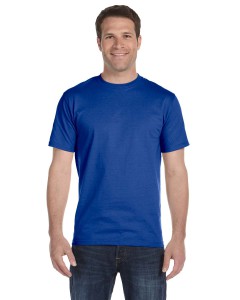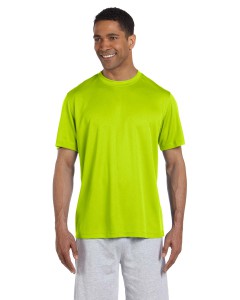When your customers request screen-printed t-shirts, how do you choose the fabric?
Many printers will simply pick the material they’re most comfortable with. But what if that’s not the best fit for the customer and their needs? A church group might appreciate maximum comfort, whereas a landscaping company will likely require durability.
In this post, we’ll go over the unique benefits and drawbacks of some common t-shirt fabrics. By selecting the right material for each project, you can help to ensure customers are super satisfied over the long term. This can mean positive word-of-mouth, repeat business, and maybe even a significant boost to profits.
Ready to get started? Let’s take a look at cotton first.
Cotton
The pros
Easy printing. In our experience, screen printers tend to prefer 100% cotton because you can print almost anything on it. The only exception involves sublimation printing, which we’ll cover later on.
Comfort. Cotton is a soft, breathable material that provides good air circulation. It’s also hypoallergenic, meaning it’s less likely to irritate customers with sensitive skin.

100% Cotton T-Shirt
The cons
Wrinkling. One big negative with cotton is that it wrinkles fairly easily. As a result, it might require more ironing than other fabrics.
Shrinking. Cotton is also susceptible to shrinking. Even “pre-shrunk” cotton shirts can get a bit snugger after they’re washed.
Lack of durability. Cotton shirts tend to break down over time, especially with frequent exposure to sunlight. If your customer spends a lot of time outside, this could be an important factor to consider.
Absorbency. Why is absorbency a bad thing? Well, if your customer is going to be sweating a lot, their cotton shirt will try to hold on to that sweat. Once the customer has cooled off, the wet cotton can make them feel clammy and uncomfortable.
Which customers would like it?
Cotton shirts can be a great choice for one-time events like conferences or family reunions. Since the shirts won’t need to be worn on a regular basis, durability isn’t likely to be a huge concern.
Even if the shirts will be worn frequently, there’s less of an issue with indoor use. For example, a bowling alley might be safe outfitting its employees in cotton shirts.
In addition, cotton should always be considered for customers who are mainly concerned with comfort.
Printing on cotton t-shirts
As mentioned above, cotton shirts are suitable for almost any printing project. They can work with standard plastisol inks, as well as water-based and discharge inks. Cotton is also the best fabric for direct to garment (DTG) printing.
The only type of printing not compatible with 100% cotton is sublimation printing. For this method, polyester is recommended.
A quick note on ring-spun cotton
You might see the term “ring-spun cotton” when you’re shopping for shirts. Simply put, ring-spun t-shirts are stronger (and softer) than regular cotton. This is due to differences in how the yarns are processed.
Ring-spun cotton is also more expensive than its regular counterpart. It’s a good choice for customers who want “extra nice” cotton shirts and are willing to pay a bit more for them.
Polyester
The pros
Athletic performance. 100% polyester t-shirts – sometimes called “performance tees” – are known for their moisture-wicking qualities. The fabric is designed to pull sweat away from your body and keep your skin dry. These shirts also have a lightweight feel, making them perfect for high-intensity physical activity.
Strength. Polyester is a durable, long-lasting material that holds up well against the elements.
Wrinkle resistance. These shirts are also less likely to wrinkle, stretch, or shrink than ones made of cotton.
The cons
Low breathability. T-shirts made from polyester don’t provide as much air circulation as cotton shirts. This can make polyester a less comfortable option for some people.

Performance Polyester T-Shirt
Printing limitations. As discussed below, polyester shirts can have issues with dye migration during the printing process.
Which customers would like it?
Sourcing wholesale polyester performance t-shirts makes a lot of sense for any kind of sports team – especially those that play outside in hot weather. The moisture-wicking feature can have a meaningful impact on performance.
Customers that will be wearing their t-shirts regularly are also good candidates for polyester. The fabric’s resistance to wrinkles and stretching makes it fairly easy to maintain. Plus, polyester shirts generally have a longer lifespan than cotton ones.
It’s worth noting that 100% polyester shirts have risen in popularity over the last ten years. They used to carry a bit of a stigma, but here at ShirtMax we feel they are the future of the industry. You might want to become familiar with polyester printing – if you’re not already – in order to stay ahead of the curve.
Printing on polyester t-shirts
You can print on 100% polyester shirts, but you’ll need to take precautions against dye migration. This is an issue that can occur when plastisol inks are used on synthetic fibers like polyester. Dye in the polyester will sometimes bleed into the ink after heating, causing a substandard print.
To combat dye migration, many printers will use low-bleed inks or avoid excessive heat during curing. It’s important to research your options thoroughly if you do decide to use polyester. Luckily, there are many dye migration resources available online.
Also be aware that 100% polyester doesn’t work well with water-based or discharge inks. Likewise, DTG printing is a poor option. On the plus side, polyester is easily the best fabric for sublimation printing.
50% cotton/50% polyester blend
The pros
The best of both worlds (sort of). 50/50 shirts have some of the same positive qualities as the two fabrics discussed above. They’re resistant to wrinkles and shrinkage like 100% polyester, and they’re also breathable like 100% cotton. However, they usually won’t possess these desirable traits to the same degree as the pure forms.
Affordability. These shirts tend to be less expensive than 100% cotton shirts and many of the performance tees. This can obviously be a big factor for some customers. For instance, the style G800 Gildan 50/50 T-Shirt is widely popular due to its quality and price point.
The cons
Not ideal for athletics. A 50/50 shirt is similar to a performance tee, but it’s still not the same thing. The unique moisture-wicking capability of a 100% polyester shirt makes it the gold standard in this area.
Printing challenges. These shirts might be soft and breathable like cotton, but they aren’t quite as easy to print on.
Which customers would like it?
For customers that are determined to pay the lowest price possible, 50/50 shirts might be the right call. In addition, some people simply like the mix of positive traits discussed above. Of course, you should also make sure they’re aware of the drawbacks.
Printing on 50/50 t-shirts
These shirts have printing limitations that are similar to those of 100% polyester shirts. Screen printers still need to guard against dye migration, and DTG printing can also be problematic. Water-based and discharge inks might be an option, but you probably won’t get the same quality that you would with pure cotton. However, many of these issues are less severe due to the lower polyester content of the fabric.
Conclusion
The pros and cons discussed above can help you guide customers to the ideal t-shirt fabric choice. Even if they have a material in mind when they come to you, they’ll probably appreciate any additional info you can provide. The bottom line is that knowing more about fabrics can make you a better – and perhaps more profitable – screen printer.
What are your favorite t-shirt fabrics to print on? Which ones are your customers asking for? Tell us about it in the comments below.
Also, if you’re looking for wholesale blank tees, take a gander at our extensive online selection.





